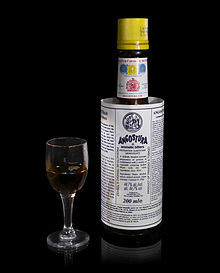Cocktail bitter
Cocktail bitters ( English bitters ) are alcoholic seasoning ingredients that are mostly used in classic cocktails . They have a more or less pronounced bitter and very intense taste and are usually only used in drops or as a dash . This is also the most important differentiator to the bitter spirits . They are typically tinctures made from many different components. A distinction can be made between those bitters in which a single ingredient is in the foreground and then gives its name (for example orange bitters , lemon bitters), and the so-calledAromatic Bitters , which are very complex aromatic compositions.
history

Probably the best-known bitter is the Angostura bitter , which the German doctor Johann Gottlieb Benjamin Siegert invented in Venezuela in 1824 as a remedy for tropical diseases. The tonic soon enjoyed growing popularity as a condiment outside of the hospitals. In the further course of the 19th century, aromatic bitters became more and more fashionable and especially conquered the bars, as an indispensable ingredient in a new type of mixed drink: the cocktails. There seemed to be no limits to the spirit of invention, as an abundance of new flavors soon became available in the form of ever new bitters. In some cocktail books of the early 20th century, over 100 different bitters are listed. The prohibition could harm the success of the bitter, as the bitter spirit were not considered and therefore still were still allowed. It wasn't until the decline of bar culture in the 1970s and 1980s that the bitters were almost forgotten. In Germany at that time only the (original) Angostura bitters, as well as an Angostura and an orange bitters from the Riemerschmid company , which are now produced by Hemmeter ( Underberg Group), were available.
It was not until the beginning of the 21st century, in the course of the rediscovery of historical cocktail recipes from the 19th and early 20th centuries, that the bitters found their place again in the bars. In Germany, The Bitter Truth , founded in 2006, contributed to this development, and in 2010 more than 20 different types of bitter were again available on the German market. In the United States , too , the number of bitter producers grew significantly during this period. Today, an almost unmanageable number of flavors is offered, and many bartenders make their bitters themselves, some of them according to historical recipes, just like in the 19th century.
Well-known bitter varieties and manufacturers

In addition to Angostura bitter as a classic aromatic bitter and orange bitter , the red Peychaud's Bitters plays an important role at the bar, for example in the Sazerac cocktail , and is one of the few bitters that has been produced continuously (since 1830). Bitters of a similar type are now often referred to as Creole Bitters . One of the best-known aromatic bitters of the 19th century was Boker's Bitters , it is mentioned several times in Jerry Thomas ' first bar book from 1862, for example with the Whiskey Cocktail , today's Old Fashioned . After the recipe was forgotten for a long time, replicas are available again today.
The types of bitters offered by many manufacturers today include various aromatic bitters and orange bitters, lemon bitters, grapefruit bitters, peach bitters and mint bitters, as well as exotic flavors such as celery (Celery Bitters) and rhubarb (rhubarb Bitters) or tonic bitters. Bitters, in which individual spices predominate, are also common, for example the bartender Dale DeGroff sells a pimento bitters. There is an Amargo Chuncho Bitter from Peru especially for the Pisco Sour . Bitters with chocolate and cocoa notes are offered by The Bitter Truth (Xocolatl Mole Bitters), the Salzburg Mozart Distillery and the liqueur manufacturer De Kuyper , among others .
Cocktail bitters are usually sold in small bottles made of colored (usually brown) glass, which, depending on the brand, contain between 50 and 300 ml . So-called dash bottles are very common , which have a plastic stopper with a small hole under the screw cap, from which only one dash (splash) of around 1 ml escapes per use - but the amount can vary widely. There are also bitters bottles with an integrated pipette for drop-by-drop dosing.
Manufacturers and brands (selection)
- Angostura Holdings, Trinidad (including Angostura Bitter )
- Sazerac Company , New Orleans , USA (Peychaud's)
- The Bitter Truth, Pullach, Germany
- Bittermens, Portland (Oregon), USA
- Fee Brothers, Rochester (New York), USA
- Gary Regan's (Orange Bitters only, via Sazerac Company)
- Hemmeter ( Underberg Group ), Munich, Germany (Angostura bitter, orange bitter)
- Hermes ( Suntory ), Japan
- Bob's Bitters, manufacturer unknown
- Scrappy's Bitters, Seattle , USA
- Bitter Tears, Los Angeles , USA
- De Kuyper , Schiedam, the Netherlands
literature
- Brad Thomas Parsons: Bitters. A spirited history of a classic cure-all, with cocktails, recipes, and formulas . Random House, New York 2011, ISBN 978-1-58008-359-1 (English).

